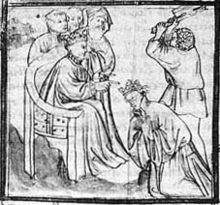| Learn more This article needs additional citations for verification. (September 2023) |
Chlodomer, also spelled Clodomir or Clodomer (c. 495 - 524) was the second of the four sons of Clovis I, King of the Franks.
| Chlodomer | |
|---|---|
 Clodomir supervises the killing of Sigismund of Burgundy | |
| King of Orléans | |
| Reign | 511–524 |
| Predecessor | Clovis I |
| Successor | Chlothar I |
| Born | c. 495 |
| Died | 524 Battle of Vézeronce |
| Spouse | Guntheuc |
| Issue | Theodebald Gunthar Clodoald |
| House | Merovingian |
| Father | Clovis I |
| Mother | Clotilde |
History
editClodomir was the eldest son of Clovis and his wife, Clotilde. On the death of his father, in 511, he divided the kingdom of the Franks with his three brothers: Theuderic I, Childebert I, and Chlothar I. Chlodomer became King of the Franks at Orléans.[1] This kingdom included, most notably, the bishoprics of Tours, Poitiers and Orléans. Chlodomer married Guntheuc, with whom he had three sons: Theodebald, Gunthar, and Clodoald.[2]
In 523–24, possibly at the instigation of his mother Clotilde, who was eager to avenge the death of her parents who had been allegedly assassinated by her uncle Gundobad, the father of Sigismund of Burgundy. From the sixth century on, the marriage of Clovis and Clotilde was made the theme of epic narratives, in which the original facts were materially altered and the various versions found their way into the works of different Frankish chroniclers.[3] The story of Clotilde's revenge is taken up by Gregory of Tours. It is, however, assumed that this tale is apocryphal.[4]
Nonetheless, Chlodomer joined with his brothers in an expedition against the Burgundians. After capturing Sigismund, Chlodomer returned to Orléans. Chlodomer had Sigismund and his sons Gisald and Gondebaud assassinated in May 524.[5]
Sigismund's brother Gondomar returned triumphantly to Burgundy at the head of the troops sent by his ally, the Ostrogothic king Theodoric the Great. There, he massacred the garrison the Franks had left behind. Chlodomer then led a second expedition against the Burgundians. He was killed on this expedition, in June that same year, at the Battle of Vézeronce.[6] Theuderic married Sigismund's daughter Suavegotha. Chlodomer's kingdom was divided such that Chlothar I received Touraine and Poitou; Childebert I the territories on both banks of the Loire with Orléans.
When his widow married Chlothar I, Chlodomer's three sons were taken to Paris and entrusted to their grandmother Clotilde. However, Chlothar, not wishing to give them a share of their father's inheritance when they came of age, murdered ten-year-old Theodebald and seven-year-old Gunthar. Only the youngest, Clodoald, was saved by the loyalty of a few of the faithful. Better known as Saint Cloud, he later became abbot of Nogent, having given up his hair, the symbol of the Frankish royalty, rather than giving up his life.[7]
References
edit- ^ "Chlodomer | Frankish Ruler, Burgundy War & Dynasty | Britannica". www.britannica.com. Retrieved 2024-01-04.
- ^ Christian Bouyer, Dictionnaire des Reines de France, Librairie Académique Perrin, 1992, p. 32-33 ISBN 2-262-00789-6
- ^ Kurth, Godefroid. "St. Clotilda". The Catholic Encyclopedia Vol. 4. New York: Robert Appleton Company, 1908. This article incorporates text from this source, which is in the public domain.
- ^ One or more of the preceding sentences incorporates text from a publication now in the public domain: Pfister, Christian (1911). "Clotilda, Saint". In Chisholm, Hugh (ed.). Encyclopædia Britannica. Vol. 6 (11th ed.). Cambridge University Press. p. 557.
- ^ Gábor Klaniczay, Holy Rulers and Blessed Princesses: Dynastic Cults in Medieval Central Europe, (Cambridge University Press, 2000), 67–68. ISBN 0-521-42018-0
- ^ Kortum, Han-Henning. "Merovingian Franks", The Oxford Encyclopedia of Medieval Warfare and Military Technology. Vol. 1. (Clifford J. Rogers, ed.) Oxford University Press (2010)
- ^ Dahn, Felix, "Chlodomer" in: Allgemeine Deutsche Biographie 47 (1903), S. 476
Further reading
edit- Bachrach, Bernard S. (1972). Merovingian Military Organization, 481–751. Minneapolis: University of Minnesota Press, ISBN 0-8166-0621-8.
- Geary, Patrick J. (1988). Before France and Germany: The Creation and Transformation of the Merovingian World. Oxford: Oxford University Press, ISBN 0-19-504458-4.
- James, Edward (1991). The Franks. London: Blackwell, ISBN 0-631-14872-8.
- Oman, Charles (1914). The Dark Ages, 476–918. London: Rivingtons.
- Wallace-Hadrill, J. M. (1962). The Long-Haired Kings, and Other Studies in Frankish History. London: Methuen.
- Wood, Ian N. (1994). The Merovingian Kingdoms, 450–751. London: Longman, ISBN 0-582-21878-0.